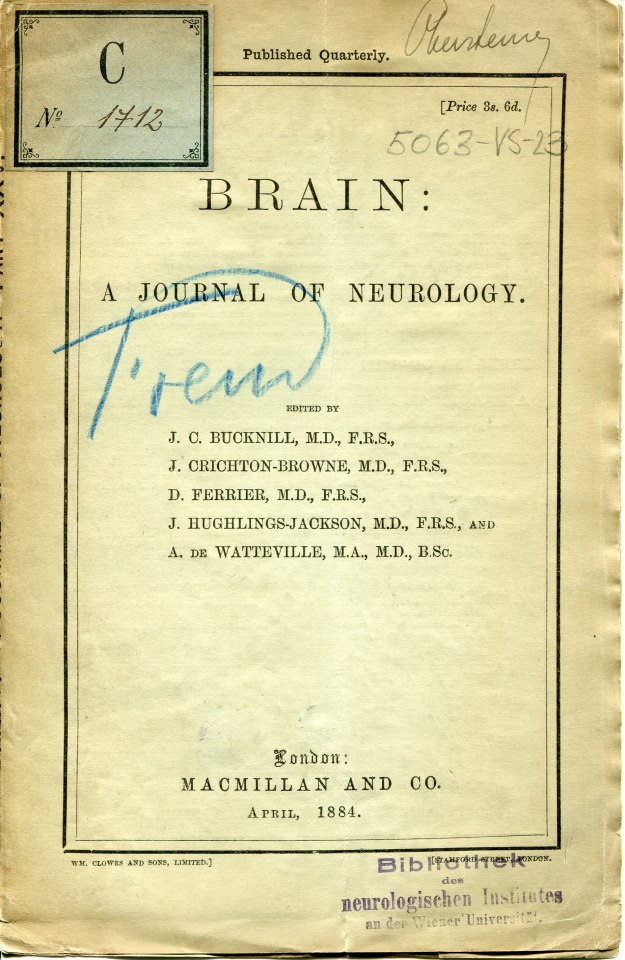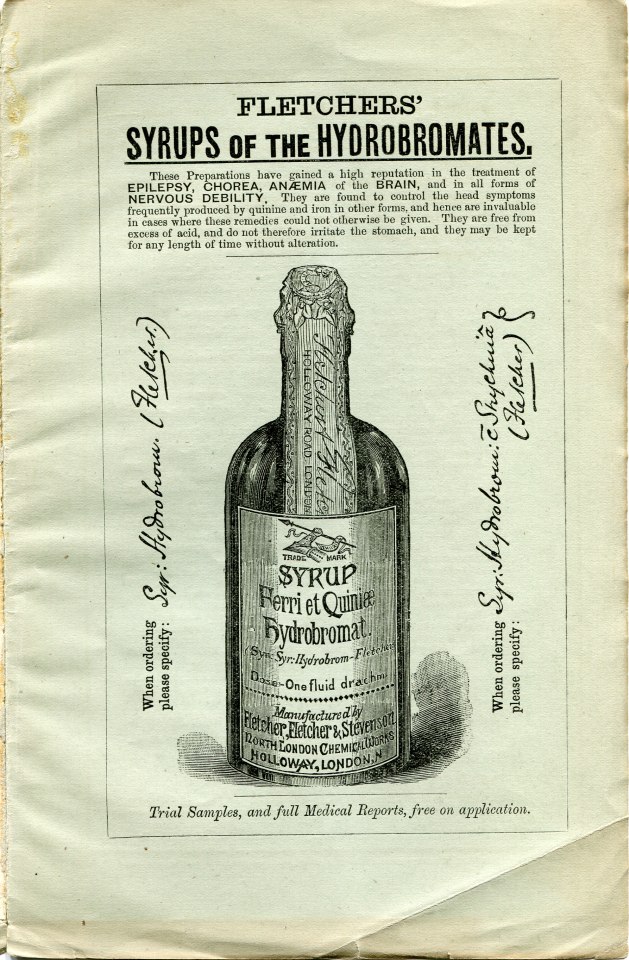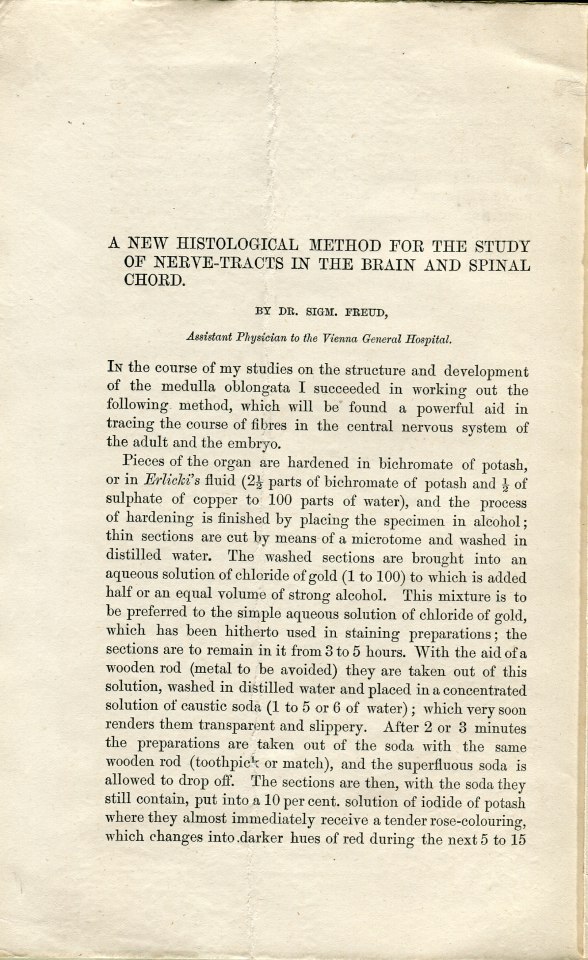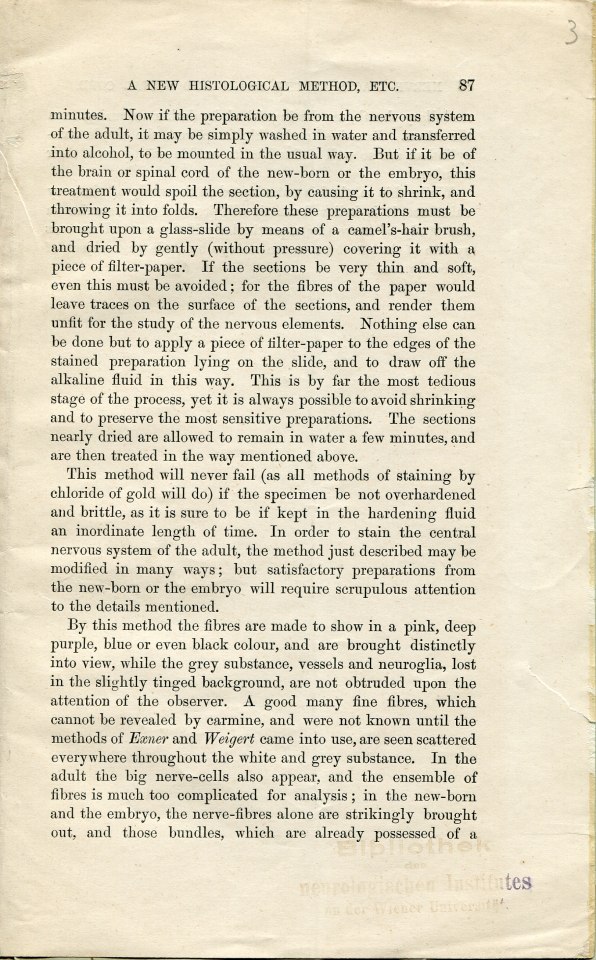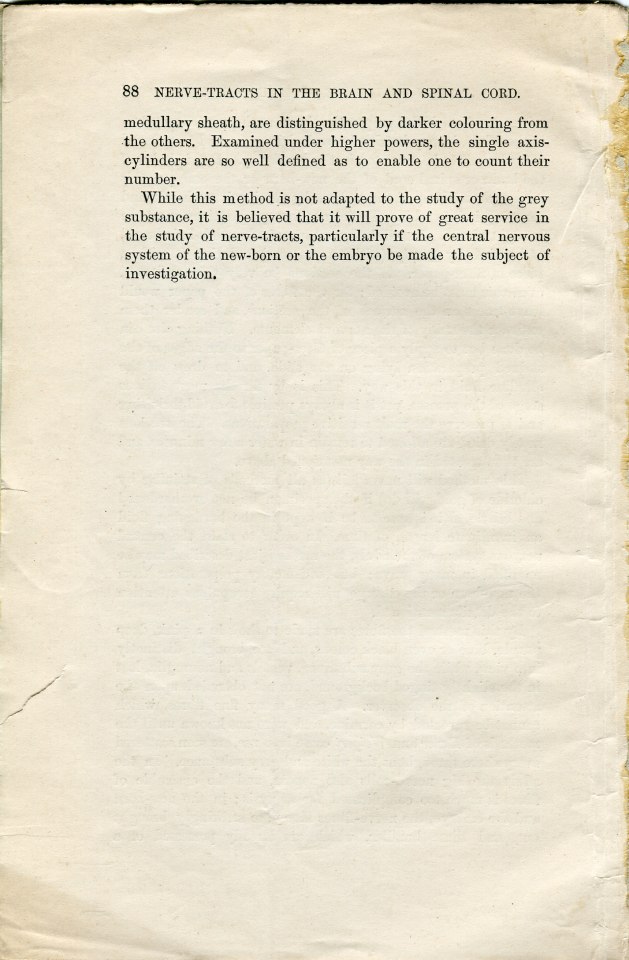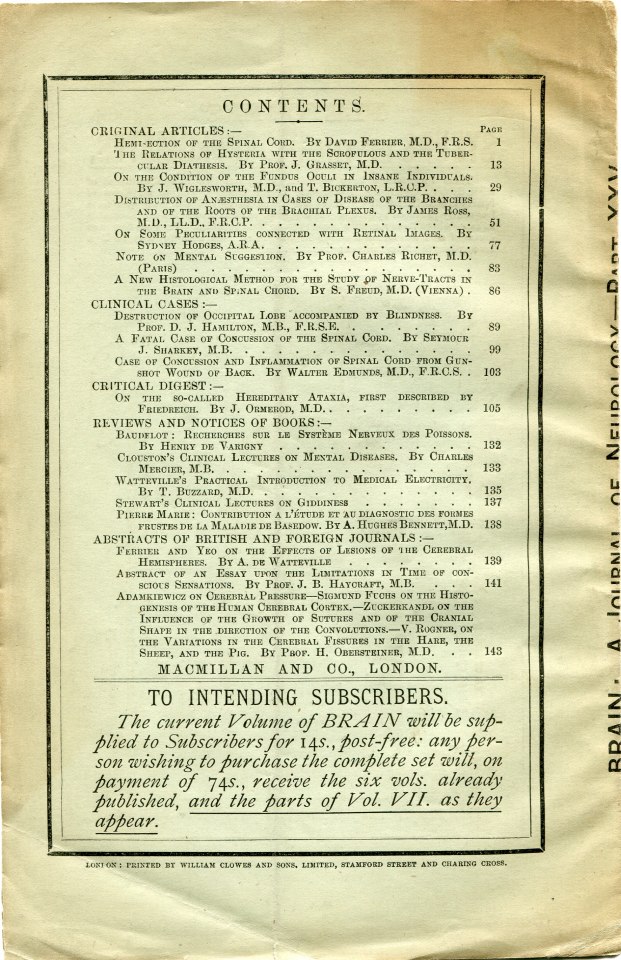S.
Published Quarterly.
[Price 3s. 6d.
BRAIN:
A JOURNAL OF NEUROLOGY.
EDITED BY
J. C. BUCKNILL, M.D., F.R.S.,
J. CRICHTON-BROWNE, M.D., F.R.S.,
D. FERRIER, M.D., F.R.S.,
J. HUGHLINGS-JACKSON, M.D., F.R.S., AND
A. DE WATTEVILLE, M.A., M.D., B.Sc.
London:
MACMILLAN AND CO.
APRIL, 1884.WM. CLOWES AND SONS, LIMITED.]
S.
‚„. „.. „..—‚__ ..-
4. .\ \ «„, _,
FLETCHERS’
SYRUPS OF THE HYDROBRUMATES.
These Prepalations have gained a. high reputation in the treatment of
EPILEPSY‚ CHOREA, AN/EMIA of the BRAIN, and in all forms of
NERVOUS DEBILITY_ They are found to control the head symptoms
frequently produced by quinine and iron in other forms, and henue are invaluable
in cases where these remedies could not otherwise be given. They are free from
excess of acid, and do not; therefore irritate the stomach, and they may be kept
for any length of time Without alteration.f%‘/7970W [%,/j
ön-- ..
>‚ 50
-äs= 5%
33 äg
ä% 'Eg«
==° °
°ä =3
0 “’s
'34 -=33394
Trial Samples, and full Medical Reports, free an application.
S.
A NEW HISTOLOGICAL METHOD FOR THE STUDY
OF NERVE-TRACTS IN THE BRAIN AND SPINAL
CHORD.BY DR. SIGM. FREUD,
Assistant Physician to the Vienna General Hospital.
In the course of my studies on the structure and development
of the medulla oblongata I succeeded in working out the
following method, which will be found a powerful aid in
tracing the course of fibres in the central nervous system of
the adult and the embryo.Pieces of the organ are hardened in bichromate of potash,
or in Erlicki’s fluid (2½ parts of bichromate of potash and ½ of
sulphate of copper to 100 parts of water), and the process
of hardening is finished by placing the specimen in alcohol;
thin sections are cut out by means of a microtome and washed in
distilled water. The washed sections are brought into an
aqueous solution of chloride of gold (1 to 100) to which is added
half or an equal volume of strong alcohol. This mixture is to
be preferred to the simple aqueous solution of chloride of gold,
which has been hitherto used in staining preparations: the
sections are to remain in it from 3 to 5 hours. With the aid of a
wooden rod (metal to be avoided) they are taken out of this
solution, washed in distilled water and placed in a concentrated
solution of caustic soda (1 to 5 or 6 of water); which very soon
renders them transparent and slippery. After 2 or 3 minutes
the preparations are taken out of the soda with the same
wooden rod (toothpick or match), and the superfluous soda is
allowed to drop off. The sections are then, with the soda they
still contain, put into a 10 per cent. solution of iodide of potash
where they almost immediately receive a tender rose-colouring,
which changes into darker hues of red during the next 5 to 15S.
A NEW HISTOLOGICAL METHOD, ETC. 87
minutes. Now if the preparation be from the nervous system
of the adult, it may be simply washed in water and transferred
into alcohol, to be mounted in the usual way. But if it be of
the brain or spinal cord of the new-born or the embryo, this
treatment would spoil the section, by causing it to shrink, and
throwing it into folds. Therefore these preparations must be
brought upon a glass—slide by means of a camel’s-hair brush,
and. dried by gently (without pressure) covering it with a
piece of filter-paper. If the sections be very thin and soft,
even this must be avoided ; for the fibres of the paper would
leave traces on the surface of the sections, and render them
unfit for the study of the nervous elements. Nothing else can
be done but to apply a piece of filter-paper to the edges of the
stained preparation lying on the slide, and to draw off the
alkaline fiuid in this way. This is by far the most tedious
stage of the process, yet it is always possible to avoid shrinking
and to preserve the most sensitive preparations. The sections
nearly dried are allowed to remain in water a few minutes, and
are then treated in the way mentioned above.This method will never fail (as all methods of staining by
chloride of gold will do) if the specimen be not overhardened
and brittle, as it is sure to be if kept in the hardening fiuid
an inordinate length of time. In order to stain the central
nervous system of the adult, the method just described may be
modified in many ways; but satisfactory preparations from
the new—born or the embryo will require scrupulous attention
to the details mentioned.By this method the fibres are made to show in a pink, deep
purple, blue or even black colour, and are brought distinctly
into view, while the grey substance, vessels and neuroglia, lost
in the slightly tinged background, are not obtruded upon the
attention of the observer. A good many fine fibres, which
cannot be revealed by carmine, and were not known until the
methods of Emner and Weigth came into use, are seen scattered
everywhere throughout the white and grey substance. In the
adult the big nerve-cells also appear, and. the ensemble of
fibres is much too complicated for analysis; in the new—born
and the embryo, the nerve—fibres alone are strikingly brought
out, and those bundles, which are already possessed of aS.
88 NERVE-TRACTS IN THE BRAIN AND SPINAL CORD.
medullary sheath, are distinguished by darker colouring from
the others. Examined under higher powers, the single axis-
cylinders are so well defined as to enable one to count their
number. }While this method _is not adapted to the study of the grey
substance, it is believed that it Will prove of great service in
the study of nerve-traets, particularly if the central nervous
system of the new-born or the embryo be made the subject of
investigation."su \\
AH.
S.
‚ „„... . ‚ „ _._„‚ .
CONTENTS
ORIGINAL ARTICLES: —
HEMI EOTION OE THE SPINAL CORD. BY DAVID FERRIER, M. D., F. R. S.
'JHE PELATIONS OE HYSTERIA WITH THE SOEOEULOUS AND THE TUBER-
CI LAH DIATHESIS. BY PROE.J. GRASSET, MD. . . .
ON THE CONDITION OE THE FUNDUS OCULI IN INSANE INDIYIDEALS.
BY J. WIGLESWORTH, M. D., and T. BICKERTON, L.R. U.P
DINTRIBUTION OE ANZESTHESIA IN CASES OF DISEASE OF THE BRANCHES
A_\I) OF TIIE ROOTS OE THE BEAOHIAL PLEXUS. BY JAMES Ross,
M. I)., LL. D. F. R. G. P. .
ON SOIIE PEOIILIAEITIES CONNEOTED WITH RETINAI. 1)IAGES. BY
SYD\'EY HODGES, A.R. A. . .
NOTE ON MENTAI. SLGGES’IION. BY PROF. CHARLES RIOHET, M. D.
(PARIS) .
A NEW HISTOLOGIOAI. METHOD FOR THE STL'DY pE NEIIVE-TEAOTS IN
THE BRAIN AND SPINAI. CHORD. BY S. FREUD, M. D. (VIENNA).
CLINICAL CASES :—
DESTRUOTION OE OCCIPITAL LOEE "AOOOMPANIED BY BLINDN'ESS. BY
PROF. D. J. HAMILTON, M..,B F. R.S.E. . .
A FATAL CASE OF CONOUSSION OE THE SPINAL CORD. BY SEYMOCR
J. SIIARKEY, M. B.
CASE OE CONOISSION AND INELAMIIATION OE SPINAI. COIID FROM GÜN-
SHOI WOOND OE BACK BY WALTER EDMUNDS, M. D., F R. C. S.
CRITICAL DIGEST :—
ON THE SO-OALLED HEREDITARY ATAXIA, FIRST DESORIBED BY
FBIEDREIOH. BY J. ORMEROD, M.D. . . . . . . .REVIEWS AND NOTICES OF BOOKS:—
BAUDELOT: RECHERCHES SUR LE SYSTEIIE NERVEUX DES POISSONS.
BY HENRY DE VAHIGNY . . . . .CLOL'STON’ s CLINIOAI. LECTIZRES ON MENTAI. DISEASES. BY CHARLES
MEHOIEII, M. B.WATTEVII.LE’s PEAOTIOAI. INTEQDUOTION TO MEDICAL ELECTRICI'I‘Y.
BY T. BUZZARD, MD. . . . . .STEWART’ s CLINICAL LECTURES ON GIDDINESS . .
PIERRE MAIIIE: CONTRIBUTION A L ’ETUDE ET AU DIAGNOSTIO DES FORMES
FRCSTES DE LA MALADIE DE BASEDOW. BY A. HUGHES BENNETT,\I. D.ABS' FRACTS OF
FERRIER AND YEO ON THE EFFECTS OE LESIONS OF 'lI—IE CEREBRAI.
HEMISPHERES. BY A. DE WATTEVILLE .ABSTRACT OF AN ESSAY UPON THE LIMITATIONS IN TIME OE CON-
SCIOIS SENSATIONS. BY PROF. J. B. HAYGRAFT, M. B.ADAMKIEWICZ ON CEREBRAL PRESSURE—SIGMUND FCCHS ON THE HISTO-
GENESIS OE THE HCMAN CEREBRAL COR’I'EX. —ZCCKERKANDL ON THE
INELUENCE OF THE GROWTH OF SUTEEES AND OE THE CRANIAI.
SHAPE IN THE DIRECTION OF THE CONVOLUTIONS. —V. ROGN‘ER, ON
THE VARIATIONS IN THE CEREEHAI. FISSURES IN THE HARE, THE
SHEEP, AND THE PIG. BY PEOE. H. OBERSTEINER, M..D .MACMILEAN AND CO., LONDON.
PAGE
1
13
2951
77
83
8689
99
103132
133135
137138
139
141143
TO INTENDING SUBSCRIBERS.
T/ze ea77em‘ V olame Of ERA [N will öe saß-
plz'ea’ z‘o Subscribers for I4S.‚ fast-free: any fer—
507z wz'skz'ag io purchase the eomplez‘e set will, anpayment of 745., receive Me six vol.»: alreaafv
ßaölz'sßzea’, ana’ the paris of Vol. VI]. as Meyaßpear.
nr: N:! Ibn! nnv—DAn-r
LONI OX : PRIXTED BY WILLXAM CLOWEB AND BOSS. LIMITED, STAMFORD STREET AND CHARING CROSS-
VV\I»
.Im IDMAI
A
RDAIM-
5.063-VS-23
86
–88
